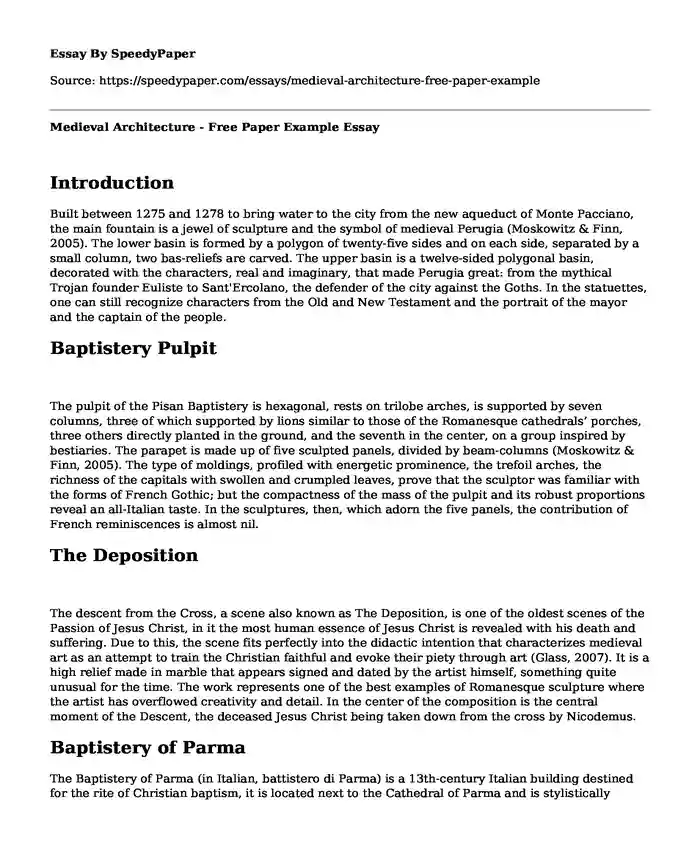
| Type of paper: | Essay |
| Categories: | History Architecture |
| Pages: | 4 |
| Wordcount: | 842 words |
Introduction
Built between 1275 and 1278 to bring water to the city from the new aqueduct of Monte Pacciano, the main fountain is a jewel of sculpture and the symbol of medieval Perugia (Moskowitz & Finn, 2005). The lower basin is formed by a polygon of twenty-five sides and on each side, separated by a small column, two bas-reliefs are carved. The upper basin is a twelve-sided polygonal basin, decorated with the characters, real and imaginary, that made Perugia great: from the mythical Trojan founder Euliste to Sant'Ercolano, the defender of the city against the Goths. In the statuettes, one can still recognize characters from the Old and New Testament and the portrait of the mayor and the captain of the people.
Baptistery Pulpit
The pulpit of the Pisan Baptistery is hexagonal, rests on trilobe arches, is supported by seven columns, three of which supported by lions similar to those of the Romanesque cathedrals’ porches, three others directly planted in the ground, and the seventh in the center, on a group inspired by bestiaries. The parapet is made up of five sculpted panels, divided by beam-columns (Moskowitz & Finn, 2005). The type of moldings, profiled with energetic prominence, the trefoil arches, the richness of the capitals with swollen and crumpled leaves, prove that the sculptor was familiar with the forms of French Gothic; but the compactness of the mass of the pulpit and its robust proportions reveal an all-Italian taste. In the sculptures, then, which adorn the five panels, the contribution of French reminiscences is almost nil.
The Deposition
The descent from the Cross, a scene also known as The Deposition, is one of the oldest scenes of the Passion of Jesus Christ, in it the most human essence of Jesus Christ is revealed with his death and suffering. Due to this, the scene fits perfectly into the didactic intention that characterizes medieval art as an attempt to train the Christian faithful and evoke their piety through art (Glass, 2007). It is a high relief made in marble that appears signed and dated by the artist himself, something quite unusual for the time. The work represents one of the best examples of Romanesque sculpture where the artist has overflowed creativity and detail. In the center of the composition is the central moment of the Descent, the deceased Jesus Christ being taken down from the cross by Nicodemus.
Baptistery of Parma
The Baptistery of Parma (in Italian, battistero di Parma) is a 13th-century Italian building destined for the rite of Christian baptism, it is located next to the Cathedral of Parma and is stylistically considered as a point of union of Romanesque architecture and gothic architecture (Glass, 2007). The external surface is decorated by a complex scheme with chiaroscuro effects. On the first floor, with three facades, there are flared portals with semicircular arches, while on the other sides there are blind arches, large like the portal itself and with columns in the center, in an unusual place. The portals are decorated by various reliefs, among which the lunettes stand out, which are probably also works by Antelami. Four upper registers are decorated by architrave colonnades, interrupted in correspondence with the buttresses on the corners. The last face is decorated by blind arches that are out of phase regarding the lower colonnades.
Parish Church
The beautiful Pieve dei Santi Ippolito e Cassiano is located in the hamlet of San Casciano, along the banks of the Arno, between Cascina and Pisa. It is a harmonious example of a Pisan Gothic style church. Documented as early as 970, it was renovated at the end of the 12th century with verrucane stones (i.e. from Monte Della Verruca) and decorated with important architectural sculptures in the lower part of the facade (Cherchi, 2017). The masterpiece is the three architraves that overlook the respective entrances, especially the central one by Biduino. The interior, with a basilica layout with three naves divided by columns and two pillars with a semicircular apse, preserves a rare immersion baptismal font, two large wooden crucifixes from the Pisan school and other works of absolute value.
Conclusion
Medieval works of art appeared in a context where the definition of art did not yet exist, nor did that of beauty, even the concept of fine arts or artists did not exist. This is why medieval art is considered one of the longest periods in the history of art. The Romanesque period was a complex movement that involved art that emerged in Europe. Romanesque art was used more for the construction of monasteries, while Gothic art focused on cathedrals, where the elevation represented the approach to God, in which the Romanesque reflected more of the monumental.
References
Cherchi, G. (2017). Images at work: Narratives in words and pictures. Journal of the Siena Academy of Sciences, 9(1). https://www.researchgate.net/publication/329112219_IMAGES_AT_WORK_NARRATIVES_IN_WORDS_AND_PICTURES
Glass, D. F. (2007). 'Quo Vadis': The study of Italian Romanesque sculpture at the beginning of the Third Millennium. Studies in Iconography, 28, 1-22. https://www.researchgate.net/publication/298655860_'Quo_Vadis'_The_study_of_Italian_Romanesque_sculpture_at_the_beginning_of_the_third_millennium
Moskowitz, A. F., & Finn, D. (2005). Nicola and Giovanni Pisano (Vol. 40). Harvey Miller Pub. http://www.brepols.net/Pages/ShowProduct.aspx?prod_id=IS-9781872501499.
Cite this page
Medieval Architecture - Free Paper Example. (2023, Nov 25). Retrieved from https://speedypaper.net/essays/medieval-architecture-free-paper-example
Request Removal
If you are the original author of this essay and no longer wish to have it published on the SpeedyPaper website, please click below to request its removal:
- NASA Mars Mission Research Paper Sample for Free
- Free Essay with the Movies Analysis
- Essay Sample on Westward Expansion and Manifest Destiny
- Why I Disagree With Robert Kaplan - Essay Sample
- Essay Sample on Venezuela in Crisis: President Manduro's Mismanagement and Oppression
- Free Essay Example: The Second Red Scare
- Shaping America's History and Politics - Essay Sample
Popular categories




